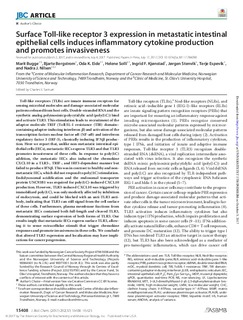| dc.contributor.author | Bugge, Marit | |
| dc.contributor.author | Bergstrøm, Bjarte | |
| dc.contributor.author | Oda Kamilla, Eide | |
| dc.contributor.author | Helene, Solli | |
| dc.contributor.author | Kjønstad, Ingrid F. | |
| dc.contributor.author | Stenvik, Jørgen | |
| dc.contributor.author | Espevik, Terje | |
| dc.contributor.author | Nilsen, Nadra J. | |
| dc.date.accessioned | 2017-10-04T08:06:35Z | |
| dc.date.available | 2017-10-04T08:06:35Z | |
| dc.date.created | 2017-08-21T09:34:23Z | |
| dc.date.issued | 2017 | |
| dc.identifier.issn | 0021-9258 | |
| dc.identifier.uri | http://hdl.handle.net/11250/2458232 | |
| dc.description.abstract | Toll-like receptors (TLR)s are innate immune receptors for microbial molecules and also sense damage-associated molecular patterns released from host cells. Double-stranded RNA and the synthetic analog polyinosinic:polycytidylic acid (Poly(I:C)) bind and activate TLR3. This leads to recruitment of the adaptor molecule TRIF (Toll-IL-1-resistance (TIR) domain-containing adaptor-inducing interferon β (IFNβ)), and downstream activation of the transcription factors nuclear factor κB (NF-κB) and interferon regulatory factor 3 (IRF-3), classically inducing IFNβ production. In this study we report that metastatic intestinal epithelial cells (IEC)s express TLR3, in contrast to non-metastatic IECs, and that TLR3 activation promotes the invasive properties of these cells. The metastatic IECs also induced CXCL10 in a TLR3- TRIF- IRF3- dependent manner in response to Poly(I:C) addition, but failed to produce IFNβ. This was in contrast to healthy and non-metastatic IECs which did not respond to Poly(I:C) stimulation. The endosomal transporter protein UNC93B1 and endolysosomal acidification was required for Poly(I:C) induced CXCL10 production, underscoring the role of endosomes in TLR3 activation. TLR3- induced CXCL10 was, however, triggered by immobilized ligand, was only modestly affected by inhibition of endocytosis, and could be blocked with an anti-TLR3 antibody, indicating that TLR3 still can signal from the cell surface of these cells. Plasma membrane fractions of metastatic IECs furthermore contained both full-length and cleaved TLR3. Our results imply that metastatic IECs express surface TLR3, allowing it to sense extracellular stimuli, which triggers chemokine responses, and promotes invasiveness in these cells. Altered TLR3 expression and localization may have implications for disease progression. | nb_NO |
| dc.language.iso | eng | nb_NO |
| dc.publisher | American Society for Biochemistry and Molecular Biology | nb_NO |
| dc.rights | Navngivelse 4.0 Internasjonal | * |
| dc.rights.uri | http://creativecommons.org/licenses/by/4.0/deed.no | * |
| dc.title | Surface Toll-Like Receptor 3 Expression in Metastatic Intestinal Epithelial Cells induces Selective Cytokine Production and Promotes Invasiveness | nb_NO |
| dc.type | Journal article | nb_NO |
| dc.type | Peer reviewed | nb_NO |
| dc.description.version | publishedVersion | nb_NO |
| dc.source.journal | Journal of Biological Chemistry | nb_NO |
| dc.identifier.doi | 10.1074/jbc.M117.784090 | |
| dc.identifier.cristin | 1487535 | |
| dc.relation.project | Norges forskningsråd: 223255/F50 | nb_NO |
| dc.relation.project | Kreftforeningen: 47069308 | nb_NO |
| dc.relation.project | Samarbeidsorganet mellom Helse Midt-Norge og NTNU: 90071001 | nb_NO |
| dc.relation.project | Samarbeidsorganet mellom Helse Midt-Norge og NTNU: 90064601 | nb_NO |
| dc.description.localcode | © 2017 by The American Society for Biochemistry and Molecular Biology, Inc. This is an open access article under the CC BY license (http://creativecommons.org/licenses/by/4.0/) | nb_NO |
| cristin.unitcode | 194,65,15,0 | |
| cristin.unitname | Institutt for kreftforskning og molekylær medisin | |
| cristin.ispublished | true | |
| cristin.fulltext | original | |
| cristin.fulltext | preprint | |
| cristin.qualitycode | 2 | |

